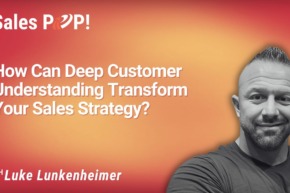Many people don’t understand the difference between inside sales and outside sales. Things get even more confusing once you throw in terms like direct sales team, and other expansions. Dionne Mischler explains what inside sales is, and how your organization can set up an amazing inside sales team in this expert sales interview, hosted by John Golden.
This expert sales interview explores:
Defining an inside sales team
How to set up an inside sales team
The importance of leading indicators
What is an Inside Sales Team?
Inside sales is a bit of an umbrella term. It’s like when you say you’re going to have a meal, there are a lot of different options that could be defined by that word. Inside sales could look like a call center, it could be a sales development team, a sales closing team, or some other variation. There is a rise in the creation of inside sales teams within a huge variety of different organizations throughout various industries, and the term might apply a little differently to each one. Ultimately, if you’re going to have an inside sales team, work on your own internal definition and make sure that everyone in your organization knows what it is so that it’s clearly defined for all employees.
Setting Up An Inside Sales Team:
It’s really important to set up your inside sales team deliberately, from the beginning. Often times, organizations will try to create the team as they go, and it ends up being disorganized and messy. When working with an organization, think about creating a team that is intentional, deliberate, and successful. Have a plan, brainstorm new ideas, and culminate those ideas onto paper so you have a baseline and ideas for the future. Also, make sure that you create your sales team with a “for now” mentality. Take into account that things will need maintenance, or there might be unexpected situations that you’ll have to adapt to. Have clear expectations, but keep your team agile.
Creating leading indicators
Leading indicators are also important when building your inside sales team. Leading indicators are all about the number of conversations and activity levels. We’re not talking about measuring calls, it’s about how visible you are with your clients, and how many genuine, real conversations you have with potential buyers. Campaigns are a great way to do this. Pick a strategic initiative so you know where to start, and have a campaign run for about a quarter. When you plan your campaign, think about the desired outcomes, and integrate that into your conversations.
Our Host
John is the Amazon bestselling author of Winning the Battle for Sales: Lessons on Closing Every Deal from the World’s Greatest Military Victories and Social Upheaval: How to Win at Social Selling. A globally acknowledged Sales & Marketing thought leader, speaker, and strategist, he has conducted over 1500 video interviews of thought leaders for Sales POP! online sales magazine & YouTube Channel and for audio podcast channels where Sales POP! is rated in the top 2% of most popular shows out of 3,320,580 podcasts globally, ranked by Listen Score. He is CSMO at Pipeliner CRM. In his spare time, John is an avid Martial Artist.




Comments